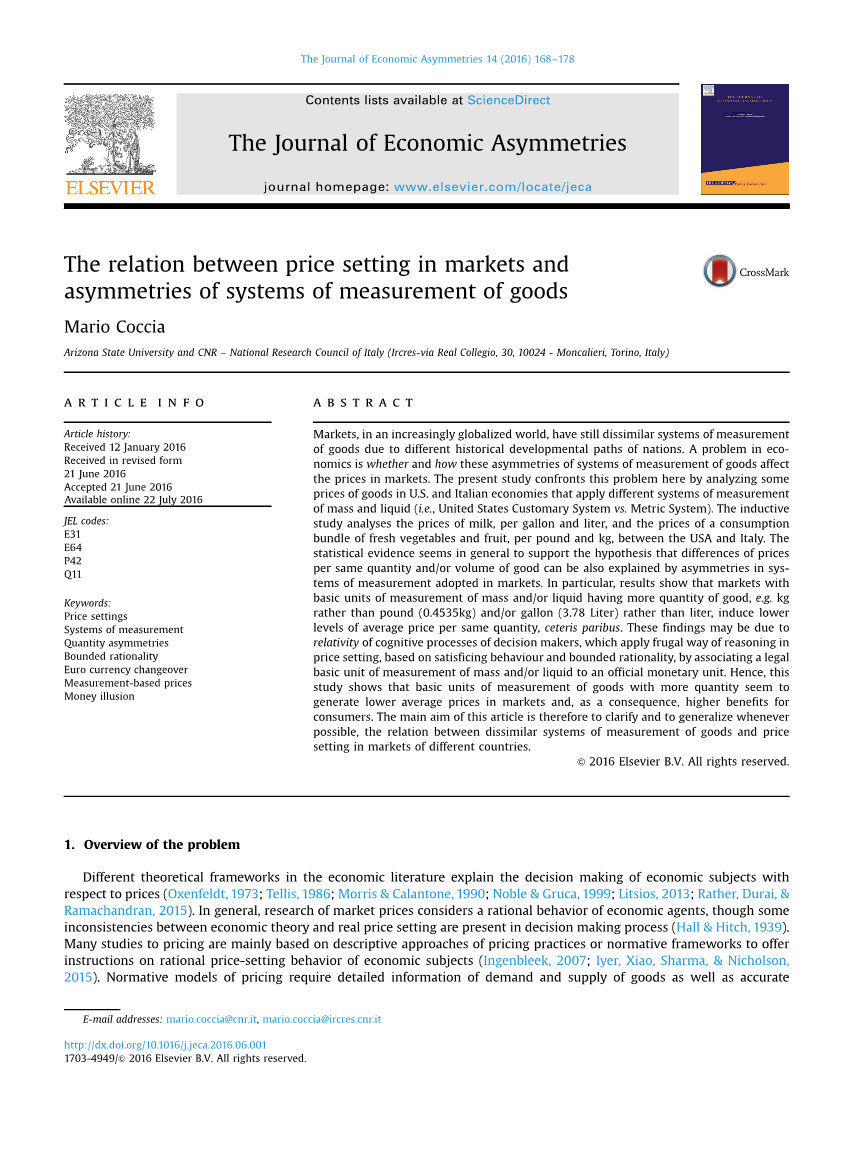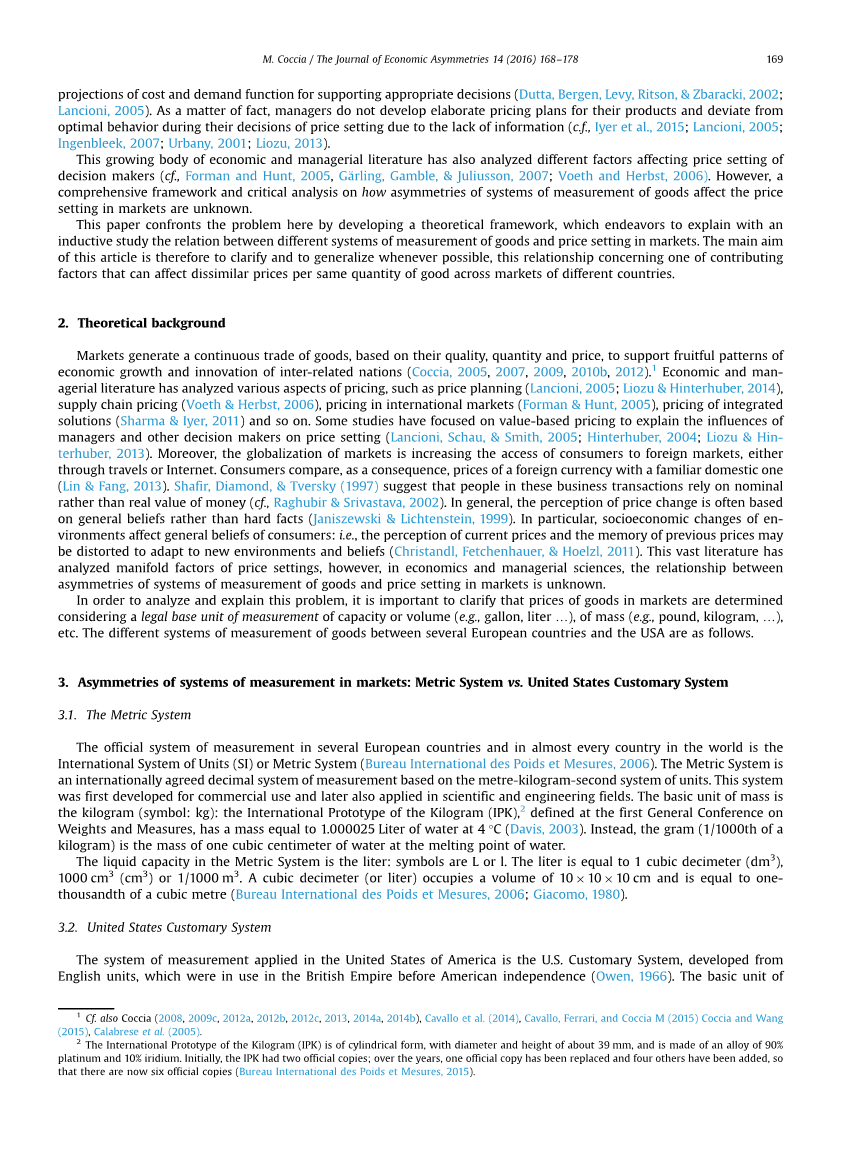

英语原文共 11 页,剩余内容已隐藏,支付完成后下载完整资料
(英文原文)
The relation between price setting in markets and asymmetries of systems of measurement of goods
Mario Coccia
Abstract
Markets, in an increasingly globalized world, have still dissimilar systems of measurement of goods due to different historical developmental paths of nations. A problem in eco-nomics is whether and how these asymmetries of systems of measurement of goods affect the prices in markets. The present study confronts this problem here by analyzing some prices of goods in U.S. and Italian economies that apply different systems of measurement of mass and liquid (i.e., United States Customary System vs. Metric System). The inductive study analyses the prices of milk, per gallon and liter, and the prices of a consumption bundle of fresh vegetables and fruit, per pound and kg, between the USA and Italy. The statistical evidence seems in general to support the hypothesis that differences of prices per same quantity and/or volume of good can be also explained by asymmetries in sys-tems of measurement adopted in markets. In particular, results show that markets with basic units of measurement of mass and/or liquid having more quantity of good, e.g. kg rather than pound (0.4535kg) and/or gallon (3.78 Liter) rather than liter, induce lower levels of average price per same quantity, ceteris paribus. These findings may be due to relativity of cognitive processes of decision makers, which apply frugal way of reasoning in price setting, based on satisficing behaviour and bounded rationality, by associating a legal basic unit of measurement of mass and/or liquid to an official monetary unit. Hence, this study shows that basic units of measurement of goods with more quantity seem to generate lower average prices in markets and, as a consequence, higher benefits for consumers. The main aim of this article is therefore to clarify and to generalize whenever possible, the relation between dissimilar systems of measurement of goods and price setting in markets of different countrie.
keywords:
Price settings
Systems of measurement Quantity asymmetries Bounded rationality
Euro currency changeover Measurement-based prices Money illusion
1. Overview of the problem
Different theoretical frameworks in the economic literature explain the decision making of economic subjects with respect to prices (Oxenfeldt, 1973; Tellis, 1986; Morris amp; Calantone, 1990; Noble amp; Gruca, 1999; Litsios, 2013; Rather, Durai, amp; Ramachandran, 2015). In general, research of market prices considers a rational behavior of economic agents, though some inconsistencies between economic theory and real price setting are present in decision making process (Hall amp; Hitch, 1939). Many studies to pricing are mainly based on descriptive approaches of pricing practices or normative frameworks to offer instructions on rational price-setting behavior of economic subjects (Ingenbleek, 2007; Iyer, Xiao, Sharma, amp; Nicholson, 2015). Normative models of pricing require detailed information of demand and supply of goods as well as accurateprojections of cost and demand function for supporting appropriate decisions (Dutta, Bergen, Levy, Ritson, amp; Zbaracki, 2002; Lancioni, 2005). As a matter of fact, managers do not develop elaborate pricing plans for their products and deviate from optimal behavior during their decisions of price setting due to the lack of information (c.f., Iyer et al., 2015; Lancioni, 2005; Ingenbleek, 2007; Urbany, 2001; Liozu, 2013).
This growing body of economic and managerial literature has also analyzed different factors affecting price setting of decision makers (cf., Forman and Hunt, 2005, Gauml;rling, Gamble, amp; Juliusson, 2007; Voeth and Herbst, 2006). However, a comprehensive framework and critical analysis on how asymmetries of systems of measurement of goods affect the price setting in markets are unknown.
This paper confronts the problem here by developing a theoretical framework, which endeavors to explain with an inductive study the relation between different systems of measurement of goods and price setting in markets. The main aim of this article is therefore to clarify and to generalize whenever possible, this relationship concerning one of contributing factors that can affect dissimilar prices per same quantity of good across markets of different countries.
2. Theoretical background
Markets generate a continuous trade of goods, based on their quality, quantity and price, to support fruitful patterns of economic growth and innovation of inter-related nations (Coccia, 2005, 2007, 2009, 2010b, 2012).1 Economic and man-agerial literature has analyzed various aspects of pricing, such as price planning (Lancioni, 2005; Liozu amp; Hinterhuber, 2014), supply chain pricing (Voeth amp; Herbst, 2006), pricing in international markets (Forman amp; H
资料编号:[144616],资料为PDF文档或Word文档,PDF文档可免费转换为Word
以上是毕业论文外文翻译,课题毕业论文、任务书、文献综述、开题报告、程序设计、图纸设计等资料可联系客服协助查找。


